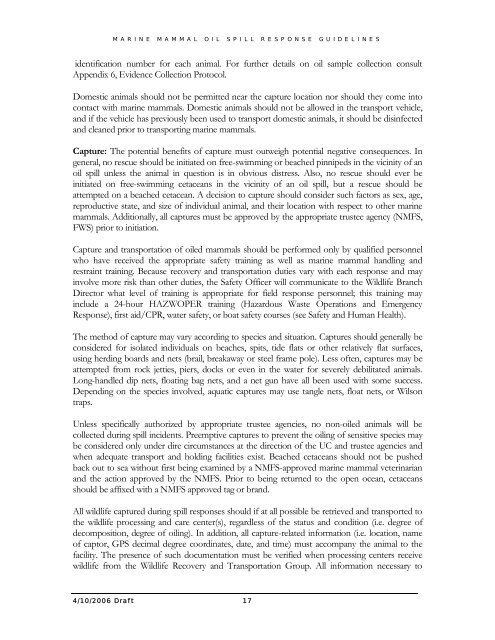Volume III, Appendices EM - National Marine Fisheries Service ...
Volume III, Appendices EM - National Marine Fisheries Service ...
Volume III, Appendices EM - National Marine Fisheries Service ...
Create successful ePaper yourself
Turn your PDF publications into a flip-book with our unique Google optimized e-Paper software.
MARINE MAMMAL OIL SPILL RESPONSE GUIDELINES<br />
identification number for each animal. For further details on oil sample collection consult<br />
Appendix 6, Evidence Collection Protocol.<br />
Domestic animals should not be permitted near the capture location nor should they come into<br />
contact with marine mammals. Domestic animals should not be allowed in the transport vehicle,<br />
and if the vehicle has previously been used to transport domestic animals, it should be disinfected<br />
and cleaned prior to transporting marine mammals.<br />
Capture: The potential benefits of capture must outweigh potential negative consequences. In<br />
general, no rescue should be initiated on free-swimming or beached pinnipeds in the vicinity of an<br />
oil spill unless the animal in question is in obvious distress. Also, no rescue should ever be<br />
initiated on free-swimming cetaceans in the vicinity of an oil spill, but a rescue should be<br />
attempted on a beached cetacean. A decision to capture should consider such factors as sex, age,<br />
reproductive state, and size of individual animal, and their location with respect to other marine<br />
mammals. Additionally, all captures must be approved by the appropriate trustee agency (NMFS,<br />
FWS) prior to initiation.<br />
Capture and transportation of oiled mammals should be performed only by qualified personnel<br />
who have received the appropriate safety training as well as marine mammal handling and<br />
restraint training. Because recovery and transportation duties vary with each response and may<br />
involve more risk than other duties, the Safety Officer will communicate to the Wildlife Branch<br />
Director what level of training is appropriate for field response personnel; this training may<br />
include a 24-hour HAZWOPER training (Hazardous Waste Operations and Emergency<br />
Response), first aid/CPR, water safety, or boat safety courses (see Safety and Human Health).<br />
The method of capture may vary according to species and situation. Captures should generally be<br />
considered for isolated individuals on beaches, spits, tide flats or other relatively flat surfaces,<br />
using herding boards and nets (brail, breakaway or steel frame pole). Less often, captures may be<br />
attempted from rock jetties, piers, docks or even in the water for severely debilitated animals.<br />
Long-handled dip nets, floating bag nets, and a net gun have all been used with some success.<br />
Depending on the species involved, aquatic captures may use tangle nets, float nets, or Wilson<br />
traps.<br />
Unless specifically authorized by appropriate trustee agencies, no non-oiled animals will be<br />
collected during spill incidents. Preemptive captures to prevent the oiling of sensitive species may<br />
be considered only under dire circumstances at the direction of the UC and trustee agencies and<br />
when adequate transport and holding facilities exist. Beached cetaceans should not be pushed<br />
back out to sea without first being examined by a NMFS-approved marine mammal veterinarian<br />
and the action approved by the NMFS. Prior to being returned to the open ocean, cetaceans<br />
should be affixed with a NMFS approved tag or brand.<br />
All wildlife captured during spill responses should if at all possible be retrieved and transported to<br />
the wildlife processing and care center(s), regardless of the status and condition (i.e. degree of<br />
decomposition, degree of oiling). In addition, all capture-related information (i.e. location, name<br />
of captor, GPS decimal degree coordinates, date, and time) must accompany the animal to the<br />
facility. The presence of such documentation must be verified when processing centers receive<br />
wildlife from the Wildlife Recovery and Transportation Group. All information necessary to<br />
4/10/2006 Draf t 17
















